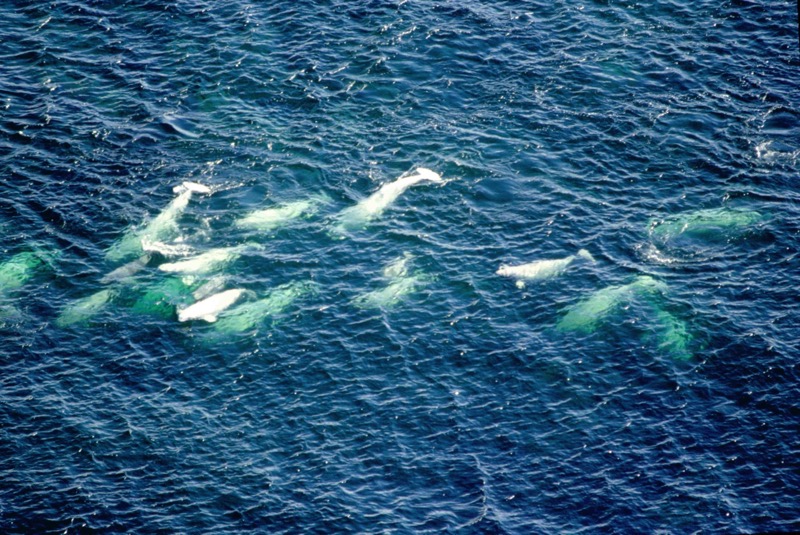In 1985, Moskva, a Russian non-nuclear icebreaker ship, gained worldwide notice. Why? Because she heard about 2,000 beluga whales stranded on ice while playing classical music. Yes, you read that right.
In February 1985, a Soviet icebreaker ploughed a 15-mile way through thick ice to release hundreds of stranded white beluga whales in one of the most unique rescue missions in the navigation history of the Arctic.
An icebreaker is a kind of ship that can readily sail at higher latitudes near the Arctic by breaking through the thickest ice. Icebreakers cut through frozen-over water or pack ice. The ice typically cracks without causing a perceptible alteration in the trim of the vessel.
When the ice is extremely thick, the ship’s bow may push into it and shatter it under the ship’s weight. Icebreakers were employed in early polar exploration trips and are still used today to clear ice trade channels and conduct polar research expeditions during the harsh Arctic winter.
Moskva was the lead ship in a series of five diesel-electric icebreakers named after important Soviet towns. Moskva is the Russian term for Moscow, the Soviet Union’s capital. She was constructed in 1959 at the Wärtsilä Hietalahti shipyard in Helsinki, Finland; when completed, she was the biggest and most powerful non-nuclear icebreaker ever built.
In December 1984, a hunter saw a herd of 3,000 beluga whales in the ice-covered coastal seas of the Chukchi Peninsula. While the hunter and his party were first pleased since belugas were nutritious, they soon realised something was amiss.
The white whales had chased an enormous school of cod into the Senyavin Strait, which divides Arakamchechen Island from the Chukchi Peninsula in the Soviet Union’s northeasternmost region, just about 130 miles from the Alaska mainland. However, an east wind sprang up and clogged the small strait with ice up to 12 feet thick, trapping the whales.
The whales couldn’t cross the vast frozen region in one breath, so they were trapped in their tiny breathing pools, waiting for a miracle to shatter the ice and release them. Like other marine animals, Belugas must climb to the surface to breathe.
At first, the villagers who found out about the whales rushed to their aid, feeding them frozen fish and drilling holes in the ice to ensure the whales had enough space to breathe. However, the winters in North-Eastern Russia can be severe, and the whales would perish beneath the heavy ice pack.
The suffering of the huge herd, believed to number 3,000, was quickly publicised by the Soviet media and the Soviet Far East authorities. Helicopters and specialists were sent to assess the situation.
Moskva, which was summoned, raced against time and freezing weather to reach the whales before they died of suffocation or starvation in diminishing areas of open water.
As part of “Operation Belukha,” Soviet media aired a report showing hordes of 10-foot-long white whales fighting for breathing space in a tiny pool of open water. At the same time, the huge Moskva ploughed ponderously toward them through the unending stretch of ice.
Moskva was usually responsible for guiding freighters across the Bering Strait, which connects Siberia and Alaska. Anatoly M. Kovalenko, the icebreaker’s captain, found the issue more difficult than expected and withdrew on the icebreaker’s initial approach to the strait, but the situation was getting dire with time as the belugas were beginning to perish.
Moskva, armed with a full tank of fuel, dived again through the ice, taking a plunge to save them, and was escorted by special spotter aircraft. While the icebreaker worked to clear a path for the whales to escape, helicopters dropped fresh fish above their breathing holes to feed them.
It took two days for the Moskva and its crew to reach the whales. The belugas, on the other hand, were frail and terrified of the huge 400-foot-long ship and its propellers.
Because no one could communicate with belugas, the Moskva gradually created bigger pools for the animals to breathe, feed, rest, and relax a little.
”Nobody could tell the captain how, in effect, to perform the most responsible stage of the operation – in what language, so to speak, to talk to the polar dolphins,” wrote the Government newspaper Izvestia as reported by New York Times in 1985. ”This operation was truly experimental.”
The whales began to gain strength and got active, whistling, playing, and celebrating. Nonetheless, they refused to accompany the ship through the canal back to the open ocean.
”[I]n a word, doing everything except one thing – entering the canal made by the icebreaker,” as reported by Izvestia.
It took an additional four days to familiarise belugas with the ship, teaching them not to fear it and its propellers.
Then, someone on the ship remembered that sea animals respond to music. As a result, music started to stream out of the upper deck. The crew played a wide range of songs, from pop to classical. After many trials, the helpless belugas began to respond to classical music and approached the icebreaker.
”Our tactic is this: We back up, then advance again into the ice, make a passage, and wait. We repeat this several times. The belugas start to ‘understand’ our intentions, and follow the icebreaker. Thus we move kilometer by kilometer,” the captain announced over the radio at his headquarters.
The whales finally became used to the ship over time. Moskva used classical music to herd the pod back to the open sea. The operation took many weeks, but by the end of February 1985, an estimated 2000 whales had been released into the ocean.
”They began coming up to the ship themselves. They hemmed it
about from all sides. They were happy as children, jumping, spreading out all over the ice field,” reported Izvestia, as per the New York Times.
Moskva served for 32 years, from the time it was delivered in 1960 until she was broken up and sold for parts in 1992. She weighed about 13,000 tonnes and was 122 metres (400 feet) in length, a one-of-a-kind diesel-electric powered ship of the time. The icebreaker escorted hundreds of ships on the North Sea trade route, but it was this one-of-a-kind operation that made Moskva famous throughout the globe.
-30-
Copyright©Madras Courier, All Rights Reserved. You may share using our article tools. Please don't cut articles from madrascourier.com and redistribute by email, post to the web, mobile phone or social media.Please send in your feed back and comments to [email protected]











